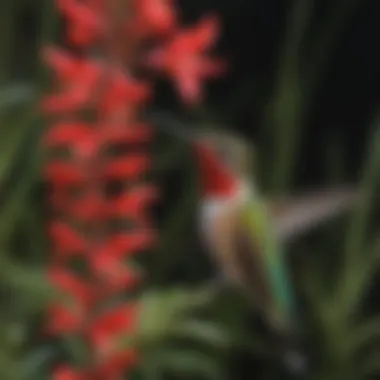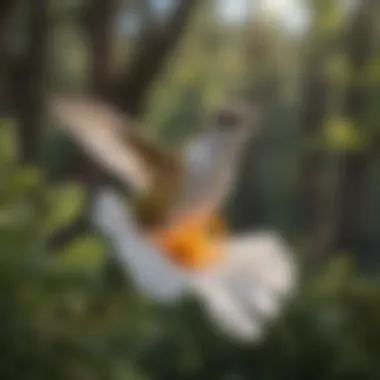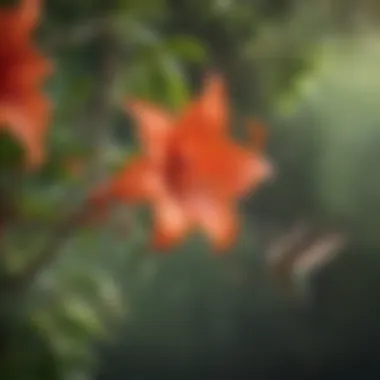Discover the Enchanting Hummingbird Flowers of California's Landscapes


Evergreen Trees Species
In the diverse landscapes of California, an array of evergreen trees adds to the natural allure of the region. From the towering Redwoods to the aromatic pines, these trees stand as stalwart guardians of the ecosystem, providing shelter, sustenance, and habitat to a plethora of wildlife species.
Ecological Significance
One cannot understate the ecological significance of evergreen trees in California. These majestic giants play a vital role in carbon sequestration, contributing to the fight against climate change. Additionally, they act as anchors for the soil, preventing erosion and maintaining the delicate balance of the ecosystem.
Conservation Practices
Amid concerns of deforestation and habitat loss, conservation efforts are paramount to preserving the biodiversity present in California's evergreen forests. Initiatives focusing on sustainable logging practices, reforestation projects, and protected areas are crucial steps towards ensuring the longevity of these valuable ecosystems.
Introduction
In the enchanting world of hummingbird flowers in California, a symphony of colors and ecological interactions awaits exploration. This article delves deep into the captivating realm where vibrant blooms and intricate relationships between hummingbirds and flowers unfold against the backdrop of California's picturesque landscapes. The importance of understanding these aspects not only enriches our knowledge but also sheds light on the delicate balance of nature, where each element plays a vital role.
Defining Hummingbird Flowers
Characteristics of Hummingbird Flowers
Hummingbird flowers exhibit unique traits that distinguish them from other floral species. These characteristics, such as bright colors, tubular shapes, and nectar-rich blooms, have evolved to attract hummingbirds, the primary pollinators. Their vivid hues act as beacons, guiding hummingbirds to nectar fountains, while their tubular structures provide exclusive access to these avian pollinators. This mutualistic relationship between hummingbird flowers and hummingbirds ensures efficient pollination and the continuation of both species.
Special Adaptations for Pollination
Special adaptations in hummingbird flowers enhance their pollination efficiency. These adaptations include long tubular shapes that accommodate the hummingbirds' slender bills, positioning of reproductive organs to facilitate pollen transfer, and production of sugary nectar to reward their avian visitors. Such adaptations not only benefit the plant by ensuring successful pollination but also highlight the intricate coevolution between hummingbirds and their floral companions.
California's Floristic Diversity


Unique Ecosystems Supporting Hummingbird Flowers
California boasts a rich tapestry of ecosystems that provide a diverse range of habitats for hummingbird flowers. From coastal scrublands to mountain meadows, each ecosystem offers unique niches where these floral gems thrive. The varied topography and microclimates in California create pockets of floral abundance, supporting a wide array of hummingbird flower species and fostering biodiversity.
Impact of Climate on Floral Distribution
The impact of climate on floral distribution plays a crucial role in shaping the presence and abundance of hummingbird flowers in California. As temperatures shift and precipitation patterns change, certain floral species may face challenges in adapting to these new conditions. Understanding the interplay between climate factors and floral distribution is essential for predicting the future landscapes of hummingbird flowers in the dynamic environment of California.
Significance of Hummingbird Flowers
Role in Ecosystems
Hummingbird flowers play a significant role in sustaining diverse ecosystems by serving as primary nectar sources for hummingbirds and other pollinators. By attracting these pollinators, hummingbird flowers facilitate the reproduction of numerous plant species, contributing to ecosystem stability and resilience. Their presence forms intricate food webs and supports the interconnectedness of flora and fauna within California's unique habitats.
Contribution to Biodiversity
The contribution of hummingbird flowers to biodiversity is invaluable, as these floral species harbor genetic diversity, support pollinator populations, and enhance ecosystem resilience. By providing essential resources like nectar and habitat, hummingbird flowers ensure the survival of various plant and animal species, contributing to the overall richness and balance of California's biodiversity mosaic.
Native Hummingbird Flowers of California
In this article, we delve into the captivating world of native hummingbird flowers found in California, highlighting their vital role in the local ecosystem and their unique characteristics that make them essential components of the floral landscape in the region. Native hummingbird flowers of California serve as crucial nectar sources for the diverse hummingbird species that inhabit the state, playing a significant role in pollination dynamics and plant reproduction. Understanding and appreciating these native flowers is key to conserving the rich biodiversity of California's flora.
Scarlet Monkeyflower (Mimulus cardinalis)
Description and Appearance
The Scarlet Monkeyflower, scientifically known as Mimulus cardinalis, is a striking native flowering plant in California characterized by its vibrant red tubular flowers that resemble tiny hummingbird beaks. This distinct feature has evolved to attract hummingbirds, which are the primary pollinators of this species. The bright red coloration serves as a visual cue for hummingbirds, guiding them towards a rich nectar source. This adaptive trait of the Scarlet Monkeyflower enhances its reproductive success by ensuring efficient pollination, making it a favored subject for observation and study in the context of plant-animal interactions within this article.
Habitat and Distribution


The Scarlet Monkeyflower thrives in moist environments along the streambanks, meadows, and shady areas of California's diverse ecosystems. Its distribution ranges from coastal regions to mountainous terrains, showcasing its adaptability to varying environmental conditions. This widespread presence of the Scarlet Monkeyflower contributes to the overall floral richness of California, providing valuable resources for native fauna and contributing to the biodiversity of the state. However, like many native species, the habitat requirements of Mimulus cardinalis make it susceptible to habitat degradation and climate change impacts, underscoring the importance of conservation efforts to safeguard its populations and associated ecosystems.
California Fuchsia (Epilobium canum)
Floral Characteristics
California Fuchsia, or Epilobium canum, is a visually striking flowering plant known for its tubular orange to red flowers that bloom profusely in late summer and fall, attracting hummingbirds with their abundant nectar resources. The tube-shaped flowers of California Fuchsia are specifically adapted to hummingbird pollination, with long stamens that rub against the birds' heads as they feed, facilitating efficient pollen transfer between flowers. This unique floral characteristic not only enhances the reproductive success of Epilobium canum but also exemplifies the intricate coevolutionary relationships between native plants and pollinators in California's ecosystems, positioning it as an essential element in this article's exploration of hummingbird flowers.
Ecological Importance
Apart from its ornamental value, California Fuchsia plays a vital ecological role in supporting local biodiversity by providing food and habitat for native hummingbirds and other wildlife species. The nectar produced by Epilobium canum serves as an energy-rich food source for hummingbirds, especially during the late flowering season when other plant resources may become scarce. Additionally, the presence of California Fuchsia in natural landscapes contributes to the restoration and conservation of native plant communities, offering both ecological benefits and aesthetic appeal. By emphasizing the ecological importance of this species, this article sheds light on the interconnectedness between native plants and wildlife in California's fragile ecosystems.
Hummingbird Sage (Salvia spathacea)
Medicinal Properties
Hummingbird Sage, scientifically known as Salvia spathacea, possesses medicinal properties that have been traditionally utilized by indigenous communities in California for various health purposes. The leaves of this aromatic herb contain compounds with antimicrobial and anti-inflammatory properties, making it a valuable resource in natural medicine practices. The medicinal use of Hummingbird Sage reflects its cultural significance and historical relevance in the region, highlighting its dual role as a medicinal plant and a critical component of California's floral diversity within the context of this article.
Cultural Significance
Beyond its medicinal properties, Hummingbird Sage holds cultural significance among indigenous groups in California, who have valued and revered this plant for its spiritual and ceremonial purposes. The plant's aromatic leaves have been used in smudging rituals to cleanse energy and promote healing, symbolizing harmony and balance in the natural world. By exploring the cultural significance of Salvia spathacea, this article aims to honor and celebrate the rich botanical heritage of California's native plants, intertwining the narratives of culture, tradition, and nature in a comprehensive depiction of the hummingbird flowers within the region.
Conservation Efforts and Challenges
In the realm of hummingbird flowers in California, understanding the critical importance of conservation efforts and the challenges they face is paramount. Conservation efforts play a vital role in preserving the delicate balance of ecosystems where these vibrant flowers thrive. By focusing on specific elements such as habitat preservation, species protection, and ecosystem sustainability, conservation efforts aim to safeguard the biodiversity and ecological integrity of hummingbird flower habitats in California. Challenges abound, from human-induced habitat loss to the adverse impacts of climate change, posing significant threats to the survival of these floral gems.
Threats to Hummingbird Flowers


Habitat Loss
Habitat loss stands out as one of the primary threats to hummingbird flowers in California. The rapid urbanization and land-use changes have led to the destruction and fragmentation of natural habitats critical for the survival of these flowers. The encroachment of human activities into pristine habitats has resulted in the loss of crucial nesting sites and foraging grounds for hummingbirds, directly impacting their population dynamics and reproductive success. Addressing habitat loss is crucial for ensuring the long-term survival of hummingbird flowers and the biodiversity they support in California.
Climate Change Impact
Climate change poses a significant challenge to the delicate balance maintained by hummingbird flowers and their ecosystems. Rising temperatures, shifting precipitation patterns, and extreme weather events disrupt the flowering cycles and distribution of plant species vital to hummingbirds. These changes not only affect the availability and abundance of nectar-rich flowers but also influence the migratory patterns of hummingbirds. Mitigating the impacts of climate change on hummingbird flowers requires comprehensive strategies that address both immediate threats and long-term sustainability.
Conservation Strategies
Protected Areas Management
Protected areas management plays a crucial role in conserving hummingbird flowers and their associated ecosystems. Establishing and maintaining protected areas ensures the preservation of critical habitats, minimizing human disturbances and promoting the recovery of threatened plant species. By implementing effective management plans, including habitat restoration, invasive species control, and monitoring programs, protected areas contribute significantly to the conservation of hummingbird flowers in California.
Community Engagement
Engaging local communities in conservation efforts is essential for the long-term success of hummingbird flower conservation. By raising awareness, educating stakeholders, and involving communities in monitoring and restoration activities, conservation initiatives gain vital support and participation. Community engagement fosters a sense of stewardship towards natural resources, encouraging sustainable practices and ensuring the continued survival of hummingbird flowers and their habitats.
Future Outlook
Looking ahead, the future of hummingbird flowers in California depends on the adoption of sustainable practices and intensified research and monitoring efforts. Emphasizing sustainable practices such as habitat restoration, pollinator-friendly gardening, and responsible land management is essential for promoting the resilience of hummingbird flowers in the face of environmental challenges. Additionally, investing in research and monitoring programs to track population trends, floral phenology, and climate impacts is critical for informed decision-making and effective conservation planning. The future outlook hinges on proactive measures and collaboration to secure a thriving habitat for hummingbird flowers and ensure their continued presence in California's diverse ecosystems.
Conclusion
In the verdant expanse of California's diverse ecosystems, the significance of hummingbird flowers reverberates magnificently. From Scarlet Monkeyflower to California Fuchsia, these floral wonders play a crucial role in maintaining ecological balance and biodiversity. As we traverse through the intricate tapestry of relationships between hummingbirds and these vibrant blooms, a deep appreciation for the harmony of nature dawns upon us. Their importance transcends mere aesthetics, delving into the very essence of ecosystem functioning and biodiversity preservation. By understanding and cherishing the beauty of hummingbird flowers, we inadvertently become stewards of nature's delicate equilibrium.
Appreciating the Beauty of Hummingbird Flowers
Ecological Harmony
The concept of ecological harmony encapsulates the delicate balance and interdependence of species within an ecosystem. In the realm of hummingbird flowers, this harmony manifests through the intricate dance between floral pollination and avian foraging practices. The key characteristic of ecological harmony lies in the precise synchronization of blooming periods with peak hummingbird activity, ensuring mutualistic benefits for both parties. This synchronization not only sustains the floral populations but also provides ample food resources for hummingbirds, creating a symbiotic relationship rooted in evolutionary wisdom. The unique feature of ecological harmony lies in its ability to maintain ecosystem resilience and stability, fostering biodiversity while safeguarding against disruptions. Although not without challenges, such as climate change and habitat fragmentation, the concept of ecological harmony remains a cornerstone in fostering sustainable coexistence among hummingbirds and their floral companions.
Inspiration for Conservation
Inspiration for conservation stems from the profound interconnectedness between hummingbird flowers and the broader ecosystem. The key characteristic of this inspiration lies in the transformative power of witnessing nature's intricate beauty and functionality. By experiencing the delicate choreography of hummingbirds sipping nectar from colorful blooms, individuals are stirred to protect and preserve these natural wonders. The unique feature of this inspiration is its ability to catalyze collective action towards environmental stewardship and habitat conservation. Through fostering a sense of awe and responsibility, the inspiration derived from hummingbird flowers fuels endeavors to safeguard fragile ecosystems and promote sustainable practices. While facing stark environmental challenges, such as habitat loss and climate change, this inspiration serves as a beacon of hope, urging us to strive for a future where hummingbird flowers continue to enchant and sustain both nature and human hearts.



